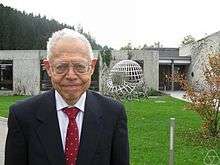Murray Gerstenhaber

Murray Gerstenhaber (born June 5, 1927) is an American mathematician, professor of mathematics at the University of Pennsylvania, best known for his contributions to theoretical physics with his discovery of Gerstenhaber algebra.
About
Gerstenhaber was born in Brooklyn. He was a child prodigy who was profiled in Leta Hollingworth's book "Children Above 180 IQ". In this book, he was dubbed "Child L" and his prodigious abilities and personality traits were described in great detail. At age 9 years 5 months, a Stanford-Binet test showed him to have a mental age of between 17 and 18 and an IQ between 195 and 198. A second revised Stanford-Binet given a year later found him to have a mental age of 19 years 11 months and an IQ of 199+. He attended the now defunct Speyer School, a school for rapid learners in New York City. After graduating from Speyer School, he entered the Bronx High School of Science in 1940. From 1945 to 1947 he served as an infantry in the United States Army. He finished his B.Sc. in mathematics at Yale University (1948). At Yale, he participated in the William Lowell Putnam Mathematical Competition and was on the team representing Yale University (along with Murray Gell-Mann and Henry O. Pollak) that won the second prize in 1947. His 1948 participation in the competition earned him a Top 10 ranking. He earned an M.A. and Ph.D. (1951) degree in mathematics from the University of Chicago, under the instruction of Abraham Adrian Albert.[1]
He was an assistant professor at the department of mathematics at the University of Pennsylvania from 1953 to 1958, rising to Associate Professor, (1958–61) and full Professor (1961–present).
Gerstenhaber earned a J.D. from the University of Pennsylvania (1973) and was admitted to Pennsylvania bar in 1974. He is also a Lecturer in Law at the University of Pennsylvania Law School.
His research interests include: Algebraic Deformation Theory, Universal Algebra, Quantum Groups and Statistics for Law.
In 2012 he became a fellow of the American Mathematical Society.[2]
References
- ↑ Murray Gerstenhaber at the Mathematics Genealogy Project
- ↑ List of Fellows of the American Mathematical Society, retrieved 2013-01-19.